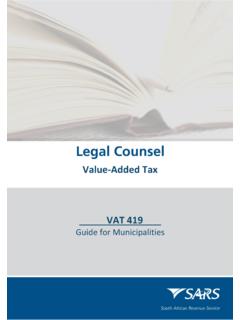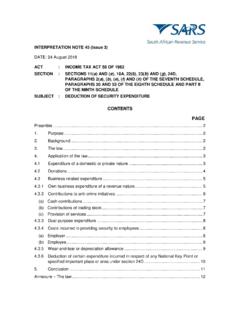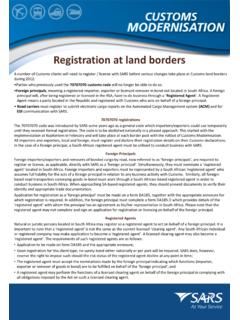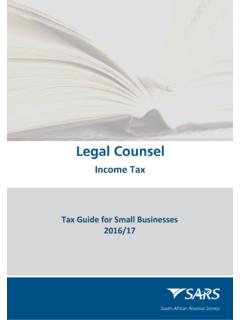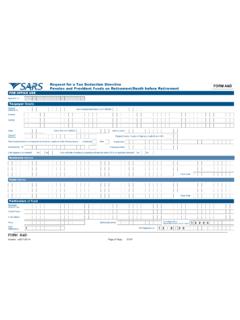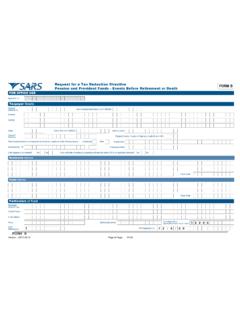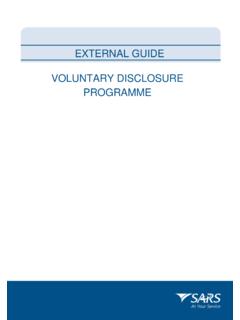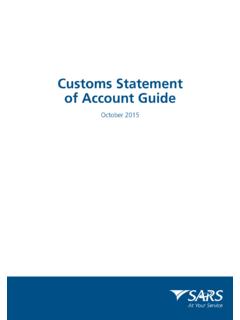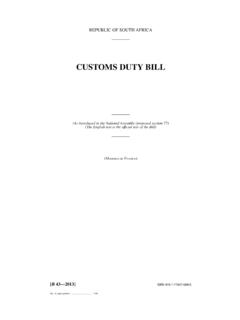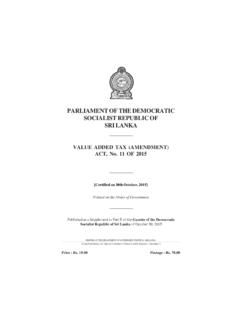Transcription of ACT : VALUE-ADDED TAX ACT NO. 89 OF 1991 SECTION ...
1 INTERPRETATION NOTE: NO. 82 DATE: 25 March 2015 ACT : VALUE-ADDED TAX ACT NO. 89 of 1991 SECTION : SECTIONS 1(1), 17(2)(c) AND 18 SUBJECT : INPUT TAX ON motor cars CONTENTS PAGE Preamble .. 2 1. Purpose .. 2 2. The law .. 2 3. Application of the law .. 2 Definition of motor car .. 2 Exclusions .. 3 Vehicles constructed or converted wholly or mainly for the carriage of passengers .. 4 Club cabs and extended cabs .. 5 Panel vans .. 6 Criteria for determining whether a vehicle is a motor car as defined .. 6 Permissible deduction of input tax on the acquisition of motor cars and the subsequent sale of such motor cars .. 7 Accessories .. 7 Accessories regarded as part of the standard structure of a motor car at the time of purchase .. 7 Accessories not forming part of the standard structure of a motor car .. 7 Modifications made to a motor vehicles.
2 8 Converting a vehicle .. 8 Converted before the supply of the vehicle .. 8 Converted after the supply of the vehicle .. 8 VAT paid on expenses relating to the running and upkeep of a motor car .. 8 Adjustment on running expenses in respect of a motor car initially acquired for a taxable purpose and subsequently applied for an exempt or private purpose .. 8 The exceptions under the provisos to SECTION 17(2)(c) .. 9 motor dealers .. 9 Demonstration vehicles .. 10 2 motor cars awarded as prizes .. 10 Concession for foreign donor funded 11 Change in use adjustments .. 11 Change in use from a taxable to a non-taxable purposes [ SECTION 18(1)] .. 12 Change in use from a non-taxable to taxable purpose [ SECTION 18(4)] .. 13 motor cars converted to game viewing vehicles and hearses [ SECTION 18(9)] .. 14 4. Conclusion .. 15 Annexure A The law .. 16 Annexure B Government Gazette No.
3 13651 .. 23 Preamble In this Note unless the context indicates otherwise SECTION means a SECTION of the VAT Act; VAT means VALUE-ADDED tax; VAT Act means the VALUE-ADDED Tax Act No. 89 of 1991 ; and any other word or expression bears the meaning ascribed to it in the VAT Act. 1. Purpose This Note sets out the interpretation of the definition of motor car ; general principle that VAT incurred on the acquisition of a motor car is not permissible as an input tax deduction; exceptions to the general principle, that is, when an input tax deduction is allowed on the acquisition of a motor car; instances when input tax may be deducted on the acquisition of accessories, modifications and conversions to motor cars ; and application of change in use adjustments to motor cars . 2. The law The relevant sections of the VAT Act are quoted in the Annexure.
4 3. Application of the law Definition of motor car The definition of motor car contains the following five categories: motor car. Station wagon. Minibus. Double cab light delivery vehicle. 3 Any other motor vehicle that is normally used on public roads; has three or more wheels; and is constructed or converted wholly or mainly for the carriage of passengers The aforementioned five categories are explained below: In Mincer Motors Ltd v Commissioner of Customs1 the court confirmed that an essential connotation of the idea of a motor car is that it is a vehicle that is designed for carrying passengers as distinct from goods . In light of this, the term motor car includes ordinary coupe (hatch-back), sedan type passenger vehicles and sport utility vehicles (SUVs) that are designed for the carrying of passengers irrespective of the means by which it is powered or propelled.
5 A station wagon2 is a car with a longer body than usual, incorporating a large carrying area behind the seats and having an extra door at the rear for easy loading. A mini-bus3 is a small bus that accommodates 10 to 15 passengers. A double cab light delivery vehicle is a four wheel pick-up truck with four doors and a reduced load capacity to accommodate up to five people. Any other motor vehicle of a kind normally used on public roads, that has three or more wheels and is constructed or converted wholly or mainly for the carriage of passengers, will generally encompass a vehicle that falls outside of the first three categories because it is not designed for the carriage of passengers only. As a result, vehicles that cast doubt as to whether they are designed for the carriage of passengers must be subjected to a test to determine whether they are designed wholly or mainly for the carriage of passengers.
6 Vehicles with these characteristics include panel vans, club cabs, single cab light and heavy delivery vehicles. This category was the subject of a court case. The court case and the test are discussed in detail in Exclusions The definition of motor car specifically excludes vehicles capable of accommodating only one person; vehicles capable of accommodating more than 16 persons (for example, a bus); vehicles with an unladen mass of 3 500 kg or more; caravans; ambulances; 1 1958 1 SA 652 (T). 2 [Accessed 20 March 2015]. 3 [Accessed 20 March 2015]. 4 vehicles constructed for a special purpose other than the carriage of persons and having no accommodation for carrying persons other than such as is incidental to that purpose; game viewing vehicles (constructed or permanently converted for the carriage of seven or more passengers for game viewing in national parks, game reserves, sanctuaries or safari areas and used exclusively, that is, more than 95% for that purpose); and hearses (as well as vehicles permanently converted into hearses).
7 Vehicles constructed or converted wholly or mainly for the carriage of passengers Once it is established that a vehicle does not fall within one of the first four categories, a determination must be made in order to confirm whether the vehicle falls within the fifth category. In order for a vehicle to fall within the fifth category, the motor vehicle must (a) be of a kind normally used on public roads; and (b) have three or more wheels; and (c) be converted or constructed wholly or mainly for the carriage of passengers. In this regard, the judgment in ITC 1596 (1995) 57 SATC 341 (T) (ITC 1596) sets out an objective test that must be applied in order to determine whether a vehicle was constructed or converted mainly for the carriage of passengers. The court stated the following in its judgement: (i) The test in determining whether a vehicle has been constructed wholly or mainly for the carriage of passengers is an objective one (objective test).
8 (ii) Mainly used in the context of wholly or mainly, implies a quantitative measurement of more than 50%. (iii) Factors to consider in determining whether the vehicle in question is intended mainly for the carriage of passengers are (aa) the total construction; (bb) assembly; (cc) appearance; (dd) space; or (ee) surface of the vehicle. Factors considered to be irrelevant and not influencing the aforementioned objective test include the (A) classification of the vehicle for licensing purposes; (B) purpose for which the vehicle is actually used; or (C) purpose for which it was acquired. What is however important, is that forgoing a certain amount of loading space for the convenience of more passenger space is an indication that the vehicle may be 5 constructed mainly for the carriage of passengers and therefore the objective test is required.
9 The objective test requires a one dimensional measurement of the length of the area designed for the carriage of passengers in relation to the dedicated loading space in a vehicle. In applying the objective test, one must determine which area measures more in length; the passenger area or the dedicated loading space. The engine area should be disregarded for the purposes of this determination. If the passenger area measures more than the dedicated loading space, the vehicle is constructed mainly (that is, more than 50%) for the carriage of passengers and will thus constitute a motor car as defined. The dedicated loading space is the area that is constructed solely for a purpose other than the carriage of passengers. There are vehicles constructed with an area within the vehicle that serves a dual purpose of providing both loading and passenger space (that is, fold-up seats that provide a loading area when folded up).
10 Due to the fact that this area can be used to accommodate passengers, the entire area will be regarded as a space designed for the seating of passengers. Once it is established that the vehicle has three or more wheels, is of a kind normally used on public roads and has been designed and constructed wholly or mainly for the carriage of passengers, the vehicle falls within the fifth category of the definition of motor car . Vehicles such as club cabs, extended cabs and panel vans do not fall squarely within the first four categories listed in the definition of motor car and therefore the objective test must be applied to these vehicles in order to determine whether such vehicles fall within the last category. These vehicles must not be construed as an exhaustive list of vehicles that are subject to the objective test. Club cabs and extended cabs motor vehicle manufacturers use a variety of terms to describe a pick-up truck, which in South Africa is commonly called a bakkie.
